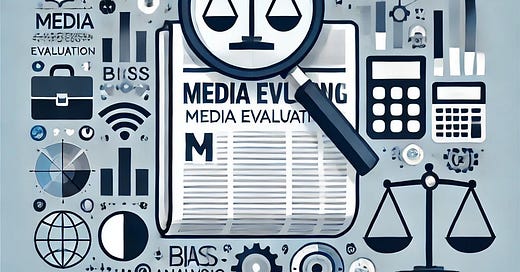📰Evaluating the Evaluators: A Guide to Media Analysis & Bias Rating Resources
Understanding the watchdogs that track journalism's trustworthiness
In an era of rampant misinformation or disinformation and media skepticism, it's crucial to assess not just individual news sources but also the organizations that evaluate them.
Below are categorized lists of major media evaluation resources—organizations that analyze news outlets for credibility, reliability, accuracy, and bias. These sites don’t function strictly as fact-checkers but as broader media watchdogs.
The lists rank and describe media evaluation resources based on their transparency, methodology, reputation, and perceived bias. While all have value, understanding their perspectives and approaches is key to using them effectively.
🧩 This is the second post in a short series about truth, media bias, and fact-checking. See The Truth Toolkit for Part 1.
Misinformation vs. Disinformation
Misinformation refers to inaccurate or misleading information shared without intent to deceive.
Disinformation refers to deliberately false information spread to mislead or manipulate.
Understanding this distinction is crucial when evaluating sources and fact-checking claims.
Note: Some of these resources provide basic evaluations for free but charge subscription fees for full access to in-depth reports, ratings, or historical data. Users should check each site's offerings before subscribing.
Independent & Multi-Perspective Media Evaluators
These organizations assess media outlets across the political spectrum, aiming for transparency and balance in their analysis. I subscribe to Ad Fontes and NewsGuard and consider them credible tools.
Ad Fontes Media – Known for its Media Bias Chart, Ad Fontes categorizes news sources based on political bias (left, center, right) and reliability in fact reporting. It uses a rigorous methodology with human reviewers and AI assistance.
NewsGuard – Provides Nutrition Labels, including a useful web browser extension, and rates thousands of news sites on credibility and transparency. NewsGuard is used by libraries, schools, and corporations and employs journalists to review sites based on strict editorial criteria.
AllSides – Compares coverage of the same stories from left, center, and right-leaning sources to highlight media bias and perspective differences. Its approach is sometimes seen as simplistic since it relies on public input and self-identification rather than independent evaluations.
Journalism & Media Watchdog Institutions
These organizations focus on ethical journalism, media accountability, and improving journalistic practices.
Columbia Journalism Review (CJR) – A prestigious journalism watchdog affiliated with Columbia University, offering deep-dive critiques of media trends and reporting practices.
Poynter Institute – A leading journalism education and research institution that also operates PolitiFact and provides guidance on ethics, media literacy, and responsible journalism.
Ideological & Advocacy-Based Media Critics
These organizations analyze media but often from a specific ideological lens, influencing their evaluations.
Media Bias/Fact Check (MBFC) – Rates media bias and factual reporting, but its methodology has been criticized for a lack of transparency and reliance on self-selected volunteers rather than trained experts.
Media Matters for America – A progressive media watchdog that monitors conservative media for misinformation, disinformation, and bias.
Fairness & Accuracy in Reporting (FAIR) – A progressive-leaning media critique organization that analyzes corporate and right-leaning media bias.
Media Research Center (MRC) – If you're interested, a conservative media watchdog that monitors and critiques mainstream media for liberal bias, often highlighting what it sees as left-leaning misinformation or disinformation.
Evaluation & Ranking Criteria
To provide a clearer picture of how these organizations operate, this assessment is based on four key factors:
Credibility – How well-sourced and fact-based their analyses are.
Reliability – The consistency and transparency of their methodology.
Accuracy – Their track record for fairness and factual correctness.
Bias – Their political or ideological leanings (if any) and how they impact evaluations.
Can AI Be Evaluated Using These Criteria?
As AI tools like ChatGPT (OpenAI), Gemini (Google), and Copilot (Microsoft) increasingly influence media consumption, evaluating them with the same framework is essential.
While AI tools provide vast amounts of information, they rely on existing sources, inherit biases from training data, and lack independent editorial judgment.
AI tools can help summarize or explain claims, but their outputs should always be cross-checked with human-led fact-checking organizations or primary sources.
The listed AI tools are rated medium in credibility and reliability, high in accuracy, and minimal but depend on data for bias.
How to Use This Information
For the most comprehensive view of media credibility and bias:
Use multiple sources – No single organization is perfect. If a story seems biased, see how different media outlets report it.
Consider ideological perspectives – Recognize when a source has a bias and balance it with other viewpoints.
Use fact-checking tools (see Truth Toolkit below) – Validate viral claims with trusted sources and cross-check AI outputs. AI is a tool, not a fact-checker.
Engage critically – Keep questioning, verifying, and refining your understanding of the news landscape. Be skeptical of headlines and viral stories. Sensationalism often signals bias.
By combining traditional media evaluation tools with AI literacy, we can navigate today’s complex media environment with greater awareness and discernment.
Other Resources
For additional tools and action-focused guides, explore these related resources from Plainly, Garbl:
The Truth Toolkit: Fact-Checking Resources for Informed Resistance
Understanding where to find reliable fact-checking resources is more critical than ever.
Local Journalism & Independent News Media
A ranked guide to advocacy groups protecting journalism, rebuilding trust, and sustaining community news.




